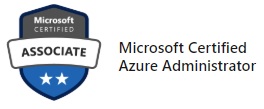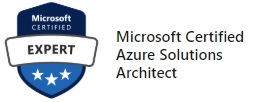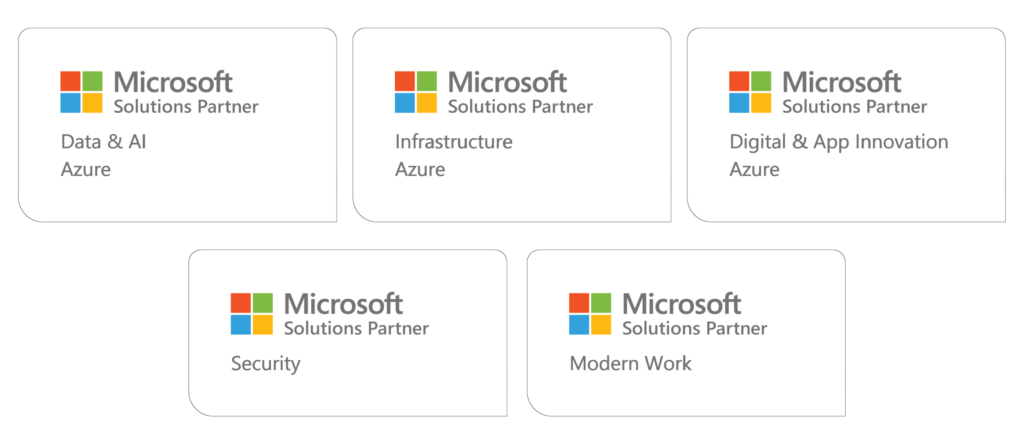MCE Microsoft Azure Solutions Architect + MCA Microsoft Azure Admin ACCELERATED COMBO Training & Certification Boot Camp – 6 Days (2 Courses, 2 Exams, 2 Certifications)
Training Schedule and Pricing
Our training model blends knowledge and certification prep into one solution. Interact face-to-face with vendor certified trainers AT OUR TRAINING CENTER IN SARASOTA, FL - OR - attend the same instructor-led live camp ONLINE.
-
Apr292024Delivery Format:CLASSROOM LIVEDate:04.29.2024 - 05.04.2024Location:SARASOTAPrice Includes:Instructor Led Class, Official Courseware, Labs and Exams$4,9956 days
-
May272024Delivery Format:CLASSROOM LIVEDate:05.27.2024 - 06.01.2024Location:SARASOTAPrice Includes:Instructor Led Class, Official Courseware, Labs and Exams$4,9956 days
-
Jun242024Delivery Format:CLASSROOM LIVEDate:06.24.2024 - 06.29.2024Location:SARASOTAPrice Includes:Instructor Led Class, Official Courseware, Labs and Exams$4,9956 days
What's Included
2 Microsoft Test Vouchers
2 Microsoft Official Courses
1 Retake Voucher (per exam, if needed)
Microsoft Study Labs & Simulations
Onsite Pearson Vue Test Center
Instructor Led Classroom Training
Certification Camps offers this accelerated combo camp for IT professionals looking to achieve the MCA Azure Admin and the MCE Azure Solutions Architect Expert certification in the shortest amount of time. The camp focuses on actual admin job task of managing Azure subscriptions, secure identities, administer the infrastructure, configure virtual networking, connect Azure and on-premises sites, manage network traffic, implement storage solutions, create and scale virtual machines, implement web apps and containers, back up and share data, and monitor your solution. Additionally - the camp covers architect task including governance, compute, application architecture, storage, data integration, authentication, networks, business continuity, and migrations.
The Microsoft Certified Azure Administrator Associate & Microsoft Certified Azure Architect Boot Camp Is Taught Using Microsoft Official Courseware Courses -
AZ-104T00: Microsoft Azure Administrator
AZ-305T00: Designing Microsoft Azure Infrastructure Solutions
While attending this 6 day camp - students will take two exams (AZ-104 / AZ-305) to achieve the Microsoft Certified Associate (MCA) Azure Administrator & Microsoft Certified Expert (MCE) Azure Solutions Architect certifications. This hands on, instructor led live camp teaches the knowledge to administer / architect an Azure environment along with the knowledge needed for the certification exams which are administered while attending.
Skills Gained:
Manage Azure identities and governance
Implement and manage storage
Deploy and manage Azure compute resources
Configure and manage virtual networking
Monitor and back up Azure resources
Design identity, governance, and monitoring solutions
Design data storage solutions
Design business continuity solutions
Design infrastructure solutions
Topics Covered in this Official Boot Camp
Microsoft Entra ID
- Describe Azure Active Directory benefits and features
- Describe Azure Active Directory concepts
- Compare Active Directory Domain Services to Azure Active Directory
- Select Azure Active Directory editions
- Implement Azure Active Directory join
- Implement Azure Active Directory self-service password reset
User / group accounts & subscriptions
- Create user accounts
- Manage user accounts
- Create bulk user accounts
- Create group accounts
- Create administrative units
- Identify Azure regions
- Implement Azure subscriptions
- Obtain an Azure subscription
- Identify Azure subscription usage
- Implement Microsoft Cost Management
- Apply resource tagging
- Apply cost savings
Policy & Role Based Access Control
- Create management groups
- Implement Azure policies
- Create Azure policies
- Create policy definitions
- Create an initiative definition
- Scope the initiative definition
- Determine compliance
- Implement role-based access control
- Create a role definition
- Create a role assignment
- Compare Azure roles to Azure Active Directory roles
- Apply role-based access control
- Review fundamental Azure RBAC roles
Resources / Resource Manager
- Use the Azure portal
- Use Azure Cloud Shell
- Use Azure PowerShell
- Use Azure CLI
- Review Azure Resource Manager benefits
- Review Azure resource terminology
- Create resource groups
- Create Azure Resource Manager locks
- Reorganize Azure resources
- Remove resources and resource groups
- Determine resource limits
Virtual Networks & Peering
- Plan virtual networks
- Create subnets
- Create virtual networks
- Plan IP addressing
- Create public IP addressing
- Associate public IP addresses
- Allocate or assign private IP addresses
- Determine Azure Virtual Network peering uses
- Determine gateway transit and connectivity
- Create virtual network peering
- Extend peering with user-defined routes and service chaining
Network Security Groups
- Implement network security groups
- Determine network security group rules
- Determine network security group effective rules
- Create network security group rules
- Implement application security groups
Azure DNS
- Identify domains and custom domains
- Verify custom domain names
- Create Azure DNS zones
- Delegate DNS domains
- Add DNS record sets
- Plan for Azure Private DNS zones
- Review Azure Private DNS zone scenarios
Network Routing & Endpoints / Load Balancer
- Review system routes
- Identify user-defined routes
- Determine service endpoint uses
- Determine service endpoint services
- Identify private link uses
- Determine Azure Load Balancer uses
- Implement a public load balancer
- Implement an internal load balancer
- Determine load balancer SKUs
- Create back-end pools
- Create health probes
- Create load balancer rules
Storage Accounts, Storage Security & Tools
- Implement Azure Storage
- Explore Azure Storage services
- Determine storage account types
- Determine replication strategies
- Access storage
- Secure storage endpoints
- Review Azure Storage security strategies
- Create shared access signatures
- Identify URI and SAS parameters
- Determine Azure Storage encryption
- Create customer-managed keys
- Apply Azure Storage security best practices
- Use Azure Storage Explorer
- Use the Azure Import/Export service
- Use the WAImportExport tool
- Use the AzCopy tool
Azure Files & FIle Sync
- Compare storage for file shares and blob data
- Manage Azure file shares
- Create file share snapshots
- Implement Azure File Sync
- Identify Azure File Sync components
- Deploy Azure File Sync
Virtual Machines, Availability & Backup
- Review cloud services responsibilities
- Plan virtual machines
- Determine virtual machine sizing
- Determine virtual machine storage
- Create virtual machines in the Azure portal
- Connect to virtual machines
- Plan for maintenance and downtime
- Create availability sets
- Review update domains and fault domains
- Review availability zones
- Compare vertical and horizontal scaling
- Implement Azure Virtual Machine Scale Sets
- Create Virtual Machine Scale Sets
- Implement autoscale
- Configure autoscale
- Explore options to protect virtual machine data
- Create virtual machine snapshots in Azure Backup
- Set up Azure Recovery Services vault backup options
- Back up your virtual machines
- Restore your virtual machines
- Implement System Center DPM and Azure Backup Server
- Compare the MARS agent and Azure Backup Server
- Implement soft delete for your virtual machines
- Implement Azure Site Recovery
Azure App Services & Plans
- Implement Azure App Service
- Create an app with App Service
- Explore continuous integration and deployment
- Create deployment slots
- Add deployment slots
- Secure your App Service app
- Create custom domain names
- Back up and restore your App Service app
- Use Azure Application Insights
- Implement Azure App Service plans
- Determine Azure App Service plan pricing
- Scale up and scale out Azure App Service
- Configure Azure App Service autoscale
Log Analysis & Network Watcher
- Determine Log Analytics uses
- Create a Log Analytics workspace
- Create Kusto (KQL) queries
- Structure Log Analytics queries
- Describe Azure Network Watcher features
- Review IP flow verify diagnostics
- Review next hop diagnostics
- Visualize the network topology
Design App Architecture, Access, and Monitoring Solutions
In this module you will learn about app architecture, authentication and authorization, and logging and monitoring solutions.
Lesson
- Design an app architecture solution
- Design authentication and authorization solutions
- Design a logging and monitoring solution
Lab : Case studies
After completing this module, students will be able to:
- Design an app architecture solution.
- Design authentication and authorization solutions.
- Design a logging and monitoring solution.
Design Network, Continuity, and Migration Solutions
In this module you will learn about networking, business continuity, and migration solutions.
Lesson
- Design a network infrastructure solution
- Design a business continuity solution
- Design a migration solution
Lab : Case studies
After completing this module, students will be able to:
- Design a networking infrastructure solution.
- Design a business continuity solution.
- Design a migration solution.
Certification Camps training is not the typical PowerPoint & Lecture presentation training center.
Certification Camps has developed a comprehensive training / delivery format which focuses on learning beyond the core content accessible to any Microsoft training provider. Our program incorporates interactive demonstrations with explanations which go beyond the content of the book. Additional content, videos, labs & demonstrations are provided to expand on advanced topics - providing additional insight and perspective.
As a Microsoft Certified Solutions Partner - we adhere to the strict guidelines, standards and requirements to use Microsoft's exclusive curriculum. More over - our standards go beyond the "minimum requirements" set forth by Microsoft Learning.
We leverage our partnership benefits of courseware customization to build end to end technology training solutions. Students gain practical skills which can be implemented immediately.
With many training centers - learning starts on the first day of class and ends on the last day. Our boot camp training program is designed to offer resources before, during and after the training event.
CERTIFICATION CAMPS FACILITIES
CAMPUS - Certification Camps built out a stand alone training center (not a hotel conference room) with spacious classrooms, new desk, Herman Miller Aeron chairs & comfortable common areas. Each student has a dedicated desk with two monitors. Each classroom has a maximum of two rows - so everyone is able to be engaged without the "back row" feeling.
CLASSROOM EQUIPMENT - Students work on a dedicated Dell Client Desktop with 32GB memory with 512GB SSD drives - All Labs are executed the extremely fast Microsoft Data Center Hosted Lab Environment .
CAMPUS INTERNET - The campus is connected with a 1Gbps (1,000 Mbps) Verizon Fios Business Connection which provides complete internet (including VPN) access for students.
COMMON AREA - Amenties including snacks, drinks (Coffee, 100% juices, sodas, etc) all complimentary.
LODGING - We use the Hyatt Place Lakewood Ranch. This "upgraded" hotel offers extremely comfortable beds, great breakfast and very fast internet access.
NEAR BY - Many shops, restaurants and grocery options are available within walking distance. Additionally - the hotel provided scheduled shuttle services. Restaurants like Cheesecake Factory, California Pizza Kitchen, Panera Bread, Bone Fish Grill, Ruby Tuesday's, Five Guys, Chipotle, Chili's and over 20 additional choices in the immediate area.













